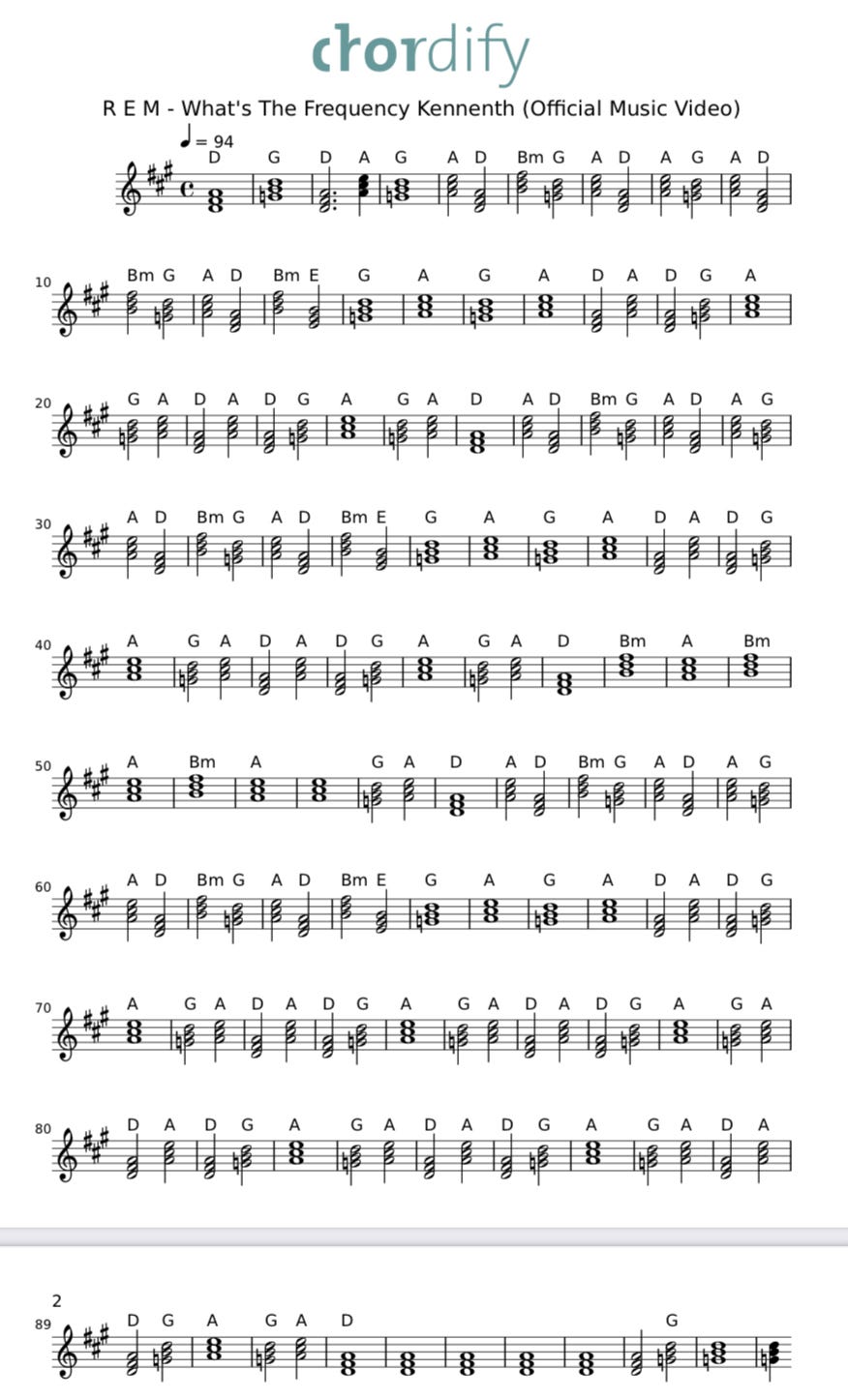The Regular Friday Post
Rando Lyrics: I take a step backwards and I fall down the same old hills
Too long for email, ….again….
Last week’s rando lyrics: The lyric, “I made a pilgrimage To save this human's race’” is from the song "I Melt With You”, by Modern English. Written by Stephen Walker, Robbie Grey, Richard Brown, Michael Conroy & Gary McDowell, (Ed. All members of Modern English at the time) it’s Track 5 on the album “After The Snow", released in August 1982 . Produced by Hugh Jones. Credit: Genius Links >I Melt With You<
Welcome to The Regular Friday post!
For Today:
I had thought I would make “I Melt With You” today’s “A Song To Play”, and started checking my usual spots (Chordify, Genius and Ultimate Guitar) for chords, lyrics and a chord chart and such. Imagine my surprise when I came across some information about the song that seemed, well, odd, to say the least. Chordify had a little yellow warning triangle as a side note that indicates a non-standard tuning for the song (for clarification, this is at the website, accessed via URL, not a feature on the mobile app). Not a non-standard guitar tuning (which is common for lots of songs), but rather a non-standard tuning for the whole song. “What could that mean?”, I said to myself, just as it’s likely you may be thinking the same thing right now.
It means Chordify heard the song as not tuned to the standard reference frequency tuning of A4=440Hz. We’ve talked about this before, but as a refresher, and for new subscribers (THANK YOU ALL!!) who may not be familiar, it goes like this: over the centuries, composers in Europe (mostly) sort of made it it up as they went along, though in different countries there began to emerge some standardization around the frequency 432Hz being equal to the piano note A4. In various places this standard was different by a few Hz (Hertz, named for Heinrich Hertz, who proved the existence of electromagnetic waves See Wikipedia: Hertz). At some point it was standardized at A4=440Hz, A4 being the note A in the 4th octave on a standard 88 key piano (in the same octave as C4, or “middle C”). There was controversy over this, as ~432Hz (commonly used previously) was thought to be pleasant, while 440Hz was felt to be unpleasant sounding, so much so that it is thought by some to be Satanic in nature. So.
I’ve listened to both as a standard reference tuning sound, there is a difference, though it is barely perceptible, and every individual’s perception may vary. It’s all subjective, but most music you hear now is standardized at 440Hz=A4, and all other notes in Western music are in frequencies measured in Hz referenced to that standard. Is it to blame for the end of civilization? I’ll reserve judgment, your mileage may vary…. OK, so is “I Melt With You” really in a reference frequency of A4=457Hz, as the little yellow warning triangle in Chordify would have us believe?
I DON’T KNOW! Since I didn’t know, I decided to go with a different song as a sort of tongue in cheek reference (see below). That song also had a non-standard tuning warning when I looked it up. Hmmm. I began to suspect an overly coincidental coincidence….
How does Chordify work, then? Well, it isn’t like your refrigerator that has a little man inside who turns off the light when you close the door. (Ed. - I once, when I was much younger, read a short “terror” fiction story that had this premise and it has stuck with me as an unpleasant, but persistent, thought since. Incidentally, the little man in your fridge is named “The Little Man Who Isn’t There”, so yeah….)
Actually Chordify uses an algorithm, based on a mathematical function. That red pill is just below this picture, so you may want to blue pill now and just go straight to the “Song To Play” section:
“The heart of the application is the Fourier Transform
What this does is take an audio signal — which is a function of time — and transform it into a new function which is in the frequency domain. So this is the step that takes the signal and figures out which notes are being played.
Once the notes have been isolated, you can apply some logic to determine what chord is made up of those notes.” Credit: A guy on Quora Link: How Do It Know?
This kind of leaves me with the question, what’s the rate of error in the algorithm and how far off is it when there is an error? I dunno, I would say it’s not uncommon, but fairly easily recognized when there is an error once you become familiar with the app. They usually appear to me as a one-off chord that just doesn’t fit, for example a single, isolated G5 or G#m chord in a song in GMajor or CMajor (or their relative minors). Kind of annoying, but not fatal: it is a very handy app, and it pretty much does just what it says it will and only a little more (Key, tempo, time signature). It won’t give you a chord chart with lyrics matched to chord changes, for instance. For that you need Ultimate Guitar, but the content there is mostly user created and versions can differ wildly. Using Chordify (which is probably mostly accurate) to check for accuracy in UG charts works pretty well, UG users also seem to hear a lot of stuff that may or may not be accurate, including lyric “mondegreens” (misheard lyrics). Check lyric accuracy in the Genius app.
If UG doesn’t have a chord chart for a song, I usually find the lyrics on Genius, chords on Chordify and make my own. That can be a bit time consuming, you have to listen closely to match timing of chord changes to lyrics, but if no one’s accurately done the work for you, and you want to add the song to your repertoire, nothing beats just doin’ it yourself.
Here’s a link to the article that explains, more or less, why Chordify thought it heard songs that use a different reference note than A4=440Hz, though in reality, it kinda just explains why it’s really everyone else’s fault. Non A4=440Hz song? Maybe. I’m reasonably sure that despite best efforts and probably continuous improvement, the algorithm still gets some non-trivial amount wrong, though usually not fatally.
A Song To Play:
Chordify thinks the “Official” version (below) is tuned to A4=440Hz, but the remastered version off the album “Monster” is A4=447Hz - meh…..
So, the “lore” has it that at some point in his career as the anchorman for CBS News, Dan Rather used the phrase “Kenneth, what’s the frequency?” on the air. I can find no confirmation of this and so it may (or may not) just be the stuff of legends. What’s true is that on a night in 1986, Mr. Rather was on his way home, was assaulted (maybe by one, maybe two assailants - online versions differ and are unclear). During the assault, an assailant repeatedly uttered the phrase “Kenneth, what’s the frequency?” as reported by Mr. Rather to police. In 1994, “What’s The Frequency, Kenneth?” was released as Track 1 on the R.E.M. album Monster, produced by R.E.M. and Scott Litt. Credit: Genius Link>Lyrics Notes<
The song was written in 1993 by Bill Berry, Mike Mills, Peter Buck and Michael Stipe (Ed. - all members of R.E.M.). Michael Stipe, at one point (according to the lore), disavowed the song had anything to do with the Rather incident, but then Mr. Rather sang the song with the band as a Letterman show bit. So, dunno, I like the song, it’s fun to play, enjoy:
Mentalfloss Article Link >What's The Frequency, Kenneth?"<
So, when I go to Chordify on my iPhone to catch the chart for “What’s The Frequency, Kenneth?” for the “Official” version it gives me an error message that the chart can’t be loaded and annoyingly suggests that maybe I should check my internet connection and retry. When I click on any of the “live in concert” versions the app immediately displays the above chart, labeled as the “Official” version. Maybe Chordify ought to check and retry. Anyway, I talked to the cat about it…..more on that below…
Lyrics - from Genius:
[Verse 1]
"What's the frequency, Kenneth?" is your Benzedrine, uh-huh
I was brain-dead, locked out, numb, not up to speed
I thought I'd pegged you an idiot's dream
Tunnel vision from the outsider's screen
[Chorus]
I never understood the frequency, uh-huh
You wore our expectations like an armored suit, uh-huh
[Verse 2]
I'd studied your cartoons, radio, music, TV, movies, magazines
Richard said, "Withdrawal in disgust is not the same as apathy"
A smile like the cartoon, tooth for a tooth
You said that irony was the shackles of youth
[Chorus]
You wore a shirt of violent green, uh-huh
I never understood the frequency, uh-huh
[Guitar Solo] (Ed. - for us non R.E.M. members, this means play whatever the hell you want for awhile. You could try to keep it in AMaj or F#minor, but it’s your time, use it however you want….)
[Verse 3]
"What's the frequency, Kenneth?" is your Benzedrine, uh-huh
Butterfly decal, rear-view mirror, dogging the scene
You smile like the cartoon, tooth for a tooth
You said that irony was the shackles of youth
[Chorus]
You wore a shirt of violent green, uh-huh
I never understood the frequency, uh-huh
You wore our expectations like an armored suit, uh-huh
I couldn't understand
You said that irony was the shackles of youth, uh-huh
I couldn't understand
You wore a shirt of violent green, uh-huh
I couldn't understand
I never understood, don't fuck with me, uh-huh
(Note - apparently the last line was removed in the “Radio Edit” version….)
Credit: Genius Link: >What's The Frequency, Kenneth? lyrics<
Other Voices:
This past Sunday (April 14th) was “Record Store Day”. Want Record Store Day in your inbox? Subscribe to Andres’ Substack and it’ll be like that all the time!
The “ME!” Section…..
What I’m Listening2: >Surprise Me, AI<
Shameless Self Promotion Section:
My song is out! Link: “Long Road Back”click on link for streaming options, then scroll down for links (or just click on these links) to Amazon, Apple, Pandora, iTunes and even (boo, hiss) Spotify
If you’re enjoying our content, please let your friends and musician acquaintances know about us!!! Thanks for supporting this free newsletter!
Disclaimer Section
This Substack is free, I receive no compensation of any kind from companies or products I mention. Some linked or quoted material may be copyrighted by others, and I credit them. I rely on the “Fair Use” doctrine for educational purposes (Link: Fair Use). *I do not use AI, things I link to might though. -Michael Acoustic
*Exception: For the next few weeks at least I’ll be testing out a beta feature offered on Substack that produces an AI image based on a text input - the image of the week can be seen in the upper left corner of this post…
Thanks for reading! Subscribe for free to receive new posts and support this newsletter.
Some Links for today
ED. None of these result in compensation to me in any way, and I’m not endorsing any of them, but some of my readers may find them as interesting as I did…
From X (Twitter):
Clarence "Gatemouth" Brown and JJ Cale - I’ve mentioned both of these fabulous musicians in previous posts, I had no idea they knew each other or performed together. Mr. Brown’s birthday would have been yesterday, April 18th. Two of the greats….
In Memoriam: Dickey Betts, Allman Brothers Band co-founder, passed away yesterday.
From Chordify:
Music Dictionary Despite annoying me occasionally, Chordify is an essential app, and this article is one reason why.
From Blues Guitar Unleashed:
Hendrix Bends Wanna bend it like Hendrix did? Check out Mr. Hamlin’s “how-to” here…
From the Disc Makers Blog:
How To Become A Singer - It’s easy!! A caveman could do it (Ed. - I might have watched a bit too much NCAA basketball lately, just sayin…). Ya just read this article and you’re a singer! OK, there’s a bit more to it, but…
ChatGPT For Music - We’ve established I’m not a fan of AI, right? I’m not a fan of AI. That doesn’t mean you shouldn’t be. Maybe this will help, though FWIW - I read it and I’m still not a fan…
Guide To Vinyl - Yeah. When you get done with this, go read Andres’ Substack, link in the “Other Voices” section above.
From Songtown:
Complicate and Confuse! - Can you even call yourself a songwriter if you’re not practicing these simple steps to success?!?!?!
You've Got This! - Well, do you? You’ll either find this very helpful or you’ll get better at writing depressing songs. The road goes ever onward, my friend….
Don't Know Anyone In The Music Business? Oh, for Pete’s sake!! You know me, don’t you? “Stop whining, you lack discipline” …and get back to work…
From Carvin Audio: (Ed. I’m a big fan of Carvin Audio. I especially like their vintage - pre bankruptcy - stuff. To their credit, they modernized and emerged out of bankruptcy to be a strong and competitive manufacturer of really high quality audio equipment again. One way they do that is through their helpful advertisements articles, often somewhat thinly disguised as something else. I’m not being critical, I’d do the same. Just so you know what’s coming.)
Play Gigs Without A Cab - “Cab” - that’s musician lingo for “cabinet” - it means a big speaker. Carvin Audio wants to sell you as many as you can afford.
Simple Solo or Duo Act Set-ups - Yeah, they would like you to buy many, many smaller speakers as well.
From American Songwriter:
The Story Of "Trigger" It’s a guitar, but it’s got some stories to tell…..
Taylor Swift Makes A Deal - I was a Taylor Swift fan back in the day, still am an admirer. Her music now isn’t my music, but I give her all the credit for knowing her audience and writing and performing songs that reach them. Can’t help but admire her business acumen as well. She just told her label how her deals are made, and they essentially just said, “OK” or more likely they said nothing at all out loud. They don’t have to, labels always win in the end, though that does not at all mean she loses, just that they’ll outlast her, eventually. Just the way it is…
From Soundfly:
Deliberate Songwriting - This is an approach, not the approach. And frankly, it’s not my approach. That doesn’t mean it’s a bad approach or a good approach. My approach is the one that works for me, but there’s plenty to consider in this article.
From ASCAP:
Generative AI Copyright - this isn’t a law yet, and may never be, but it’s interesting.
Thank You To Our New Subscribers and Followers!! This Week’s Conversation With Mika, the Cat:
Me: “What do you think, girl?”
Mika : “I think Chordify should get their head out of their ass….”
Cheers and keep playing!!
Michael Acoustic
“It’s never really final - you just run out of things you can bear to change…”









A440 and the Tritone — the Devil's tuning and also His interval too!
Definitely don’t say A440 three times in a row... A440! A440! A…
One of these days I'm for sure gonna do an in-depth post myself about this very subject. Fascinating! I have actually been in live performance situations where followers of the A432 Cult have refused to play with anyone tuned to A440. When asked — why? personally, I've never been given a rational methodical answer or argument that I can follow. Honestly, I am really open to having this explained to me, it's just that no one has ever been able to do that yet. I'm still waiting. Meanwhile, the music history I learned in university (yeah yeah, I know how that sounds, like I know it all) is different to what you point to in your article…
Bach, wrote a compendium of pieces in all keys called (translated into English) The Well-Tempered Clavier (https://en.wikipedia.org/wiki/The_Well-Tempered_Clavier). It was composed in two parts before 1722, and published as a complete work in that year. It was a big deal back then because a/ the idea of a unified system of 24 musical keys was a new, emerging contemporary idea, and Bach was a composer at the forefront of this technique. The Well-Tempered Clavier basically demonstrated how to do this — write in these 24 keys. And b/ because Bach (and other travelling composers of the time) noticed that their works sounded differently in different cities around Europe because there was no agreed system of tuning… there was “Well-temperament” tuning, “Meantone temperament” tuning, and several other competing tuning systems. Not to mention that, let’s say, that the tuning fork used to tune the organ in the cathedral in Heidelberg, would be tuned to a completely different note than the tuning fork used to tune the organ in the cathedral in Saltzburg (for instance).
So… and this is the point… nobody, not even the most experty of experts knows for sure what the A4 note of this piece was intended to be tuned to in 1722!!!!! People have theorised. But no one knows for sure. At very best, and this is still a stretch, experts can say that A4 was somewhere between 420Hz and 460Hz. That's more or less the range of geographical tuning variance for A4 in central Europe at the time (I'm just coming to that now).
And, for sure, almost all music around Europe at that time was tuned differently depending on what city or country you were in… tuning was more linked to what other musicians in your location did, than any unified system. Bach (and other well-travelled composers) recognised this. And The Well-Tempered Clavier was an attempt to establish the 12-note well-tempered tuning system as standard. It worked. It’s what all modern diatonic harmony is based upon (so all the songs by The Beatles, The Beach Boys etc etc).
Add to this that Hertz (Hz), as a unit of measuring frequency cycles was established in 1935, and named after a German who lived in the second half of the 19th century…
I mention this because one of the most popular modern-day New Agey explanations as to why A432 should be the angelic-harmonious standard and not the demonic A440 — is that (and you’re gonna have to google this and delve into it yourselves ‘coz right at this moment the name evades me) someone quite recently (second half of last century) discovered a hidden cypher in the bible that reveals (in Hertz) the exact frequencies (again I emphasise in Hz) of the Solfeggio frequency sequence, which are apparently the notes and pitches that are exactly in tune with the healing energies of the universe. And to align with this A4 needs to be 432Hz. NOT 440Hz — which is out of alignment with this healing frequency sequence. Really? In the Bible, there is a hidden reference to Hertz cycles, a system introduced in 1935????
Let’s be clear, I’m certain about the healing capabilities of electromagnet waves (sound), I don’t dispute that at all. But enough with the fairy tales, the conspiracy theories and the history re-writes. When someone can show me some data and field studies that back up that data, I’ll change from A440 to A432 (or whatever). Until then, I keep an open mind and stay away from the A432 Cult.
A couple of comments ...
One of the reasons I still like REM so much is I consider Michael Stipe's voice as a lead "instrument" on their tracks and not just a unique vocal. It's hard for me to put that into words (pun not intended), but i'm always drawn to the way he uses it.
Second, RIP Dickey Betts. His melodic answers to Duane's fierce stylings on the AB early tracks and liver performances are fantastic. And "Jessica" is still a mainstay on my playlists. Another part of my youth has passed away.